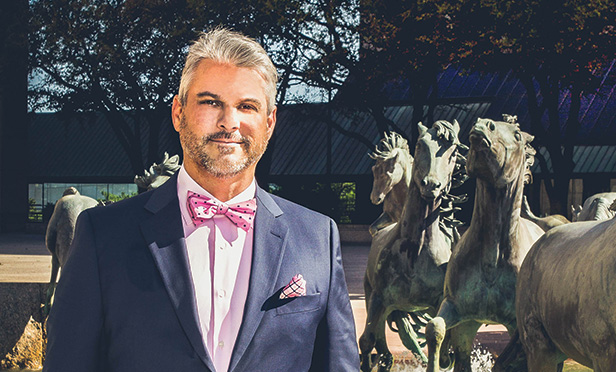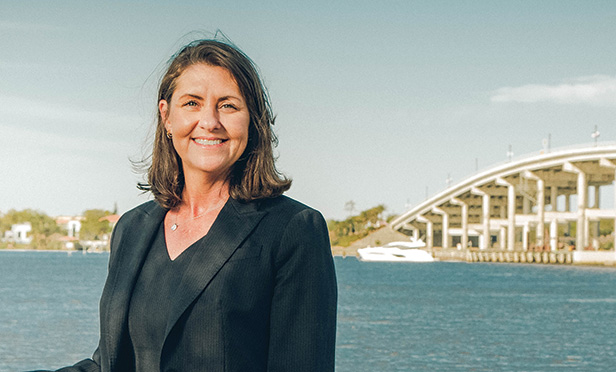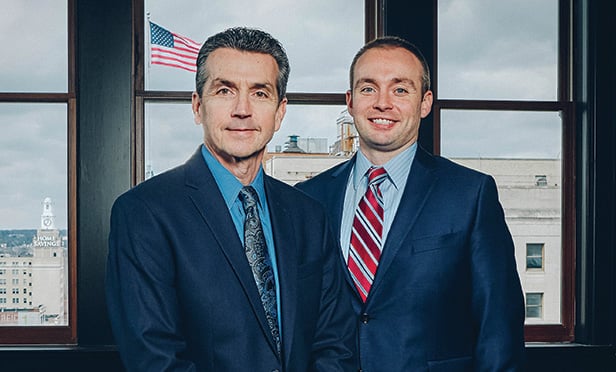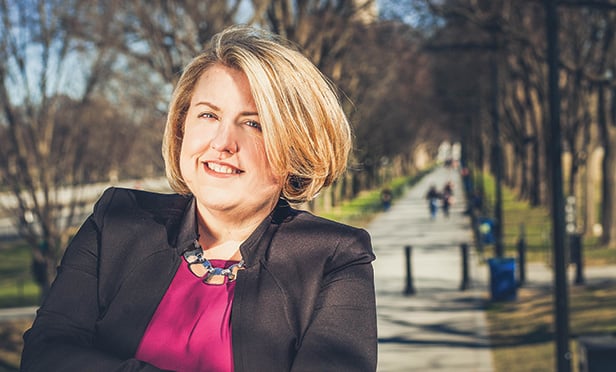The 2018 Broker of the Year finalists share some things in common.
They embrace disruption and new ways of thinking about the benefits industry, and they emphasize their roles as consultants who provide a range of services. And like many in the industry, they understand the importance of technology and data analytics—but they believe that communication and educating both clients and employees is key to using these new tools effectively.
Educating brokers is another recurring theme—agencies are putting more resources into training their people and redefining best practices. Finally, they recognize that an improving economy means that employers are looking for new ideas and options in employee benefits in order to attract and retain the talent they need.
Read on to learn more about this year's final five.
AN APPETITE FOR LEARNING
 Bret Brummitt | AG Insurance Agencies (Photo: Shane Kislack)
Bret Brummitt | AG Insurance Agencies (Photo: Shane Kislack)Bret Brummitt has been with AG Insurance Agencies in Fort Worth, Texas, for 18 years. Now a senior consultant, he admits to a few growing pains when he began his career. “A milestone for me was being able to go to sleep at night and feeling like I hadn't screwed up,” he recalls. “It was a matter of getting over the uncertainty of selling a non-physical product. I just wanted to make sure it was all OK.”
One of the things that gave him confidence as his career progressed was meeting with clients. “It really transformed the way I interacted with others,” Brummitt says. “I had some 'aha' moments about how to communicate. It wasn't too long before I started taking on more roles and more responsibility. It was a process of growing my own communications skill set.”
Pushing the envelope
Brummitt says that if he has a criticism of the benefits industry, it's that it hasn't kept up with the rest of the world when it comes to providing clients with a consumer-friendly product. “It's a bit antiquated,” he says. “Were in a business where new things pop up all the time, and we have to be ready for that. If we're not willing to learn, we're not good consultants.”
As part of his push to learn new ideas and seek innovation, Brummitt has joined industry groups such as Health Rosetta and the Q4 Intelligence Network. And like a lot of forward-looking brokers, Brummitt is also exploring the idea of a more transparent, fee-based brokerage model.
“When it comes to transparency, I think it all comes down to someone wanting to see what they're paying for and having control over their experience,” he says. “Broker compensation has become a big topic of conversation,” he adds. “I think that's a very healthy conversation, and I'm in the process of transitioning to more and more fee-based work. I'd love to say I've flipped the switch and done it overnight, but that's just not the reality for myself or my firm.”
A different market
Brummitt notes that the market in Texas has been ahead of national trends in one way—many of the state's consumers were comfortable with high-deductible health plans before those products were common in other markets.
“The consumer mentality was different here. We've been living in the high-deductible realm for a lot longer than other areas of the country,” he says. “I was selling $2,500-deductible plans in 1997. The tolerance of the consumer was better; it was fine to not have so many things covered by the health plan and just pay for things as they come up.”
But the continuing increase of both health insurance premiums and deductibles has made a difference, he adds. “As most traditional product prices have been driven up over the past five or six years, there's been a cry for the plans to cover more. When you had a high-deductible plan, pre-ACA, you weren't paying that much. Today, those same plans cost three to five times what they did previously. That's caused people to want more in return. I think it's changed the temperature and caught us up to other regions.”
Learning the language
Brummitt is a strong believer in the importance of learning new things as a broker. He says today's benefits market is forcing brokers to become more educated on health care topics. “I believe we're hitting a new tipping point,” he says. “As we get into more conversations about controlling health care costs, provider costs and medical management, one of the biggest challenges will be brokers adapting to medical terminology that they haven't been used to. We're used to talking about business and regulation, but talking about clinical outcomes and what metrics mean, I think that's going to be the big challenge over the next five to ten years.”
SHAPING THE FUTURE
 Julie Freidus | Brown and Brown Insurance (Photo: Kevin Garrett)
Julie Freidus | Brown and Brown Insurance (Photo: Kevin Garrett)Julie Freidus is not only a top producer for Brown and Brown Insurance, she also plays a key role training other brokers at the firm.
“My primary job is retaining my block of business, but my leadership duties include running the broker development program. I train all the new folks and make sure they are prepared when they roll out into sales.”
Freidus admits to being busy, but says the work is rewarding. “I really enjoy what I do,” she says. “I enjoy working with clients, and I enjoy working with younger folks—sometimes I think they teach me more than I teach them!”
Training the next generation
Freidus has been training new brokers since she started at the company. “All of our teammates spend time training new hires,” she notes. “We have a very strong culture of teamwork.”
She says the training program has expanded a lot since she started with Brown and Brown. “At first, it was one trainee here or there, but it's grown into a full-blown broker development program. We recruit talent to become part of the program, and we train them here and also at the Brown and Brown University.”
So what does a promising broker candidate look like? “We're looking for high-quality individuals who are smart, hard working, and who have a sense of urgency,” Freidus says. No background in insurance is necessary, she adds. “We feel we can train people in insurance—the people we end up hiring are up for the challenge. They're not just looking for a job, they're looking for a career.”
Communication and consultation
As for her sales strategy, Freidus says it's not rocket science. “I always do what's best for the client. I've done that since day one. It's part of the culture at Brown and Brown, one of our core values,” she says. “I think the clients see that and they appreciate it.”
Like many Broker of the Year finalists, Freidus sees herself as a consultant, not just a broker. “I take a very consultative approach,” she says. Part of that is bringing resources such as technology solutions to the table.
“I think employer groups are looking for cost containment and benefits efficiencies,” she says. “Vendors and insurance companies are always coming up with new technologies and better reporting to focus on how to solve the cost-containment challenge, especially with drilling down to the analytics and utilization of each group.”
With so many companies seeking cost containment, she says, getting buy-in from employees has never been so important. “Employee education and engagement is a large challenge that we're focusing on. As technology becomes more advanced, the data becomes much better—it presents a huge opportunity to become more engaged with consumers in terms of managing their health.”
Communication is important, she adds, but there will always be room for the personal touch. “There are so many different ways to communicate with employees now—text messages, apps, and face-to-face meetings. That sometimes gets lost, but face-to-face meetings can be very valuable in addition to the technology.
“At the end of the day it's important to remember that this is a relationship business.”
NEW MODEL, SAME PRINCIPLES
 Bob Gearhart Sr. & Bob Gearhart Jr. | DCW (Photo: Tom McKenzie)
Bob Gearhart Sr. & Bob Gearhart Jr. | DCW (Photo: Tom McKenzie)Bob Gearhart Sr. and Bob Gearhart Jr. are the successors to a longstanding insurance consulting business. Gearhart Sr.'s mother, Connie Gearhart, founded the company in 1991 to help people who were falling through the cracks between employer retirement insurance plans and Medicare.
“There was no Medigap insurance then,” Gearhart Sr. says. “It spoke volumes about how screwed up the claims system was at the time that you had to have an intermediary help you know how to file a claim, first with a company retirement health plan, and then with Medicare. So we started out as health care claims consultants.”
The Gearharts' company, DCW, is today emphasizing consulting over a traditional insurance brokerage model. With a focus on developing a fee-for-performance approach, they say the firm represents a step forward for the industry.
“Last June, we stopped quoting,” Gearhart Sr. says. “We will not quote any group, regardless of size or circumstance. People will not change for a slightly better version of what they already have. What we do is manage the health care supply chain—as well or better than anybody, I believe.” “We're not insurance professionals, we're business consultants.” Gearhart Jr. adds. “This organization started in the first place by responding to a demand, listening to a client and providing value where they needed it.”
Disruption within the industry in recent years has been a good thing, notes Gearhart Sr., and he credits his son for thinking outside the box and helping the company thrive in a post-ACA world. “In 2006, everybody seemed to be relying on similar tactics and strategies with rates and benefits,” Gearhart Sr. says. “Everybody was doing the same things, including me. I was thankful for the changes that came with the ACA—this was an industry ripe for change.”
Walking away from business
The Gearharts have created a firm that emphasizes transparency and full-fee disclosure. They believe so strongly in their approach that they have turned down business from clients who prefer a more traditional system. “The outline of the small and midsize model is, 'Let us quote for free, and you'll make your decision based on who gives away the most stuff,'” Gearhart Jr. says. “The model in the jumbo arena is similar, but slightly different: 'We have a chief medical officer, we'll bring in a team of five people, four of whom you'll never see again…'
“I get a lot of pushback from other advisors, but from our perspective, if what we're telling you will actually work, why shouldn't we tie our fee to results?”
On the other hand, Gearhart Jr. adds, “I have yet to get pushback from an employer who is self-funded.”
Communication and engagement
Much of the fee-for-service movement is associated with technology, specifically data analytics, but the Gearharts say technology is just one part of the new model. “We deploy technology at a very high rate,” says Gearhart Sr., “On the account management side, we need to free people up to communicate, and technology enables us to do that.” Gearhart Jr. notes that while data can help employers identify cost drivers, companies have to work closely with consultants to monitor and understand the data. “In order for us to be effective at managing the health supply chain, we need to double the amount of employee engagement and communication of your typical advisor,” he says.
Back to basics
Gearhart Jr. says that even though the firm that he and his father lead has evolved over the years, it still comes down to responding to the market. “That's what we do: we listen to the clients, we watch the market, and we continue to deliver value,” he says. “Clients will pay you more for results than carriers will pay you to distribute a product. It's a business model issue, and it's one that has always been in the background of our story.”
IDENTIFYING ISSUES, SOLVING PROBLEMS
 Billy Potter | Snellings Walters (Photo: Kevin Garrett)
Billy Potter | Snellings Walters (Photo: Kevin Garrett)Billy Potter is passionate about his work as a principal at Snellings Walters, but he still keeps a sense of humor. When asked about his rise as a broker, he breaks out a line from Bill Murray: “Well, it's a Cinderella story.”
Potter is kidding, but he's not far wrong. When Potter was a kid playing baseball, his coach was Bill Snellings, who happened to own Snellings Walters. Bill thought enough of Potter that he predicted he would someday work for him, and years later, the prediction came true—and Potter has continued to impress ever since.
Potter says his approach to being a broker emphasizes the fundamentals. “It's really just basic blocking and tackling,” he says. “We attribute a lot of our success to identifying the right issue within the organization. If you identify the issues, it usually takes care of itself. A lot of companies are just looking at the wrong issues.”
As an example, Potter notes the trend of wellness programs. He says that although they have value, they don't actually save much money in the benefits area. “If you're doing it to boost company morale, that's a phenomenal reason to do it,” he says. “But most companies have been loose about managing this budget item.”
Gaining traction
Potter and his firm are dedicated to the principles of the entrepreneurial operating system (EOS), espoused in the book “Traction” by Gino Wickman. “Businesses are different, but the issues are the same,” Potter explains. “We're being trained every week on how to identify issues, how to discuss them, and how to solve them for our clients.”
To get everyone on the same page, the company has required reading assignments, which Potter says help create a unified culture. It has also led to results: Since 2010, the agency has increased their employee benefits revenue sevenfold. “I feel like we've morphed into an insurance industry think tank,” he says. “We have very robust and detailed processes to help build our business in a way that we think will reshape the industry.”
Consider the workers' comp model
Potter says he looks to workers' comp insurance as a system that has lessons for the benefits side of the equation. “Those methodologies have proven very successful,” he says. “We have a process for picking up a box or wearing safety glasses, and there needs to be some similar level of boundaries for health care.
“We have a lot of ways to educate people; it starts with identifying the right issues,” he adds. “And you probably don't have to pour a lot of time and money into anything other than education. That's what workers' comp has done. They do it monthly; they do it weekly. They call it 'drug free workplace,' or they call it 'safety training.' They've quantified it.”
The impact of health insurance
Potter believes great things can be accomplished with passion and accountability. “I feel that our clients are experiencing that,” he says. “I'm very humbled by the results that we've driven and the responses we've received, not only for the C-suite, but for the people working on the line. They've been very grateful.
“Health insurance is a sensitive subject,” Potter adds. “It covers the people who employees care most about in this world, and it's frustrating because they're spending a lot of money on something they know little about. So, I'm grateful for the opportunity to make an impact on their lives.”
A PERSONAL TOUCH
 Beth Robertson | NFP (Photo: Patrice Gilbert)
Beth Robertson | NFP (Photo: Patrice Gilbert)When Beth Robertson was beginning her career, she had a supervisor who was hard to please. “I would send her my reports, and everything I wrote, she would mark it up with a red pen and send it back—everything! That experience was pivotal, because it taught me how to communicate well,” she says.
Those communication skills have helped Robertson, who works in the D.C. area, become a top producer at New York-based brokerage NFP. Robertson says the company prides itself on its personal touch. “Our model is a little bit different,” she says. “We're very client-focused. NFP has acquired many smaller firms, but we tend to maintain each office and the culture of the office that was with the original organization.”
Robertson's clients range from companies with 100 employees to 5,000 employees, and two-thirds are self-funded. “I try to ensure that every client is receiving the exact same level of service, the same level of thoughtful strategy, from me and my team,” she says. “I believe that because the benefit spend is usually number two or three for most companies, every organization has to put thought behind their strategies.”
A new era
Robertson says the market has settled down a bit from the early days of the ACA, when everyone worried about being compliant with new health care reforms. Today's employers, she adds, are much more focused on attracting and retaining employees. “Businesses are fighting for talent,” she notes. “So the employers are always trying to make sure they're offering the best benefits.”
The fight for talent has led companies to become more creative and embrace disruption, Robertson adds. “Employers are becoming more and more savvy. A lot of that is because of the great brokers and consultants out there. There's just much more creativity coming from all facets of health care, and that's driving the market.”
This shift toward embracing change has not come naturally for all, Robertson notes. But she sees it as essential to helping companies truly tackle benefit issues. “If you don't have a client that is willing to embrace disruption, you're not going to be able to do very much for them,” she says. “One of the first things I ask a client is 'What is your approach to disruption?' I tell them we need to rip the Band-Aid off, and I ask them to consider whether it's possible to make sweeping changes without some sort of disruption.”
It comes back to communication
Robertson says she believes her ability to communicate, and to tailor communications to the audience she's talking to, is her strongest skill. With insurance, she adds, it's important to adopt an approach that is more fun for clients. “I love to laugh,” she says. “It doesn't matter how I'm communicating, I'm always trying to make sure it's crisp and clear. And I always bring some humor to the situation; that's just who I am.”
Finally, she says it's important to get out from behind the desk and meet face to face. She says that personal interaction is a great way to learn. “In my career, I don't aspire to be the president, or CEO; my first love is consulting,” Robertson says. “I've been down the management path, but I always come back to consulting. My happiest days are the ones I spend with clients.”
© 2025 ALM Global, LLC, All Rights Reserved. Request academic re-use from www.copyright.com. All other uses, submit a request to [email protected]. For more information visit Asset & Logo Licensing.







